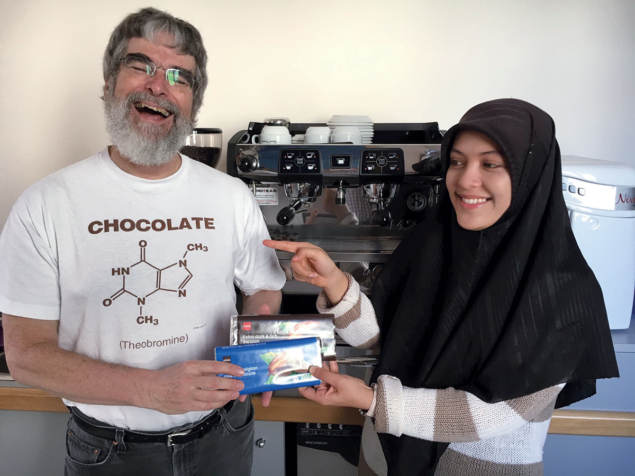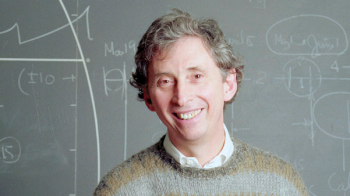Residents of the Vatican Observatory describe life as a full-time physicist in the church.

“Our job is to be part of the scientific community and show that there can be religious people and priests who are scientists,” says Gabriele Gionti, a Roman Catholic priest and theoretical physicist specialising in quantum gravity who is resident at the Vatican Observatory.
“Our mission is to do good science,” agrees Guy Consolmagno, a noted planetary scientist, Jesuit brother and the observatory’s director. “I like to say we are missionaries of science to the believers.”
Not only missionaries of faith, then, but also of science. And there are advantages.
“At the Vatican Observatory, we don’t have to write proposals, we don’t have to worry about tenure and we don’t have to have results in three years to get our money renewed,” says Consolmagno, who is directly appointed by the Pope. “It changes the nature of the research that is available to us.”
“Here I have had time to just study,” says Gionti, who explains that he was able to extend his research to string theory as a result of this extra freedom. “If you are a postdoc or under tenure, you don’t have this opportunity.”
“I remember telling a friend of mine that I don’t have to write grant proposals, and he said, ‘how do I get in on this?’” jokes Consolmagno, a native of Detroit. “I said that he needed to take a vow of celibacy. He replied, ‘it’s worth it!’.”
Cannonball moment
Clad in T-shirts, Gionti and Consolmagno don’t resemble the priests and monks seen in movies. They are connected to monastic tradition, but do not withdraw from the world. As well as being full-time physicists, both are members of the Society of Jesus – a religious order that traces its origin to 1521, when Saint Ignatius of Loyola was struck in the leg by a cannonball at the Battle of Pamplona. Today they help staff at an institution that was founded in 1891, though its origins arguably date back to attempts to fix the date for Easter in 1582.
“It was at the end of the 19th century that the myth began that the church was anti-science, and they would use Galileo as the excuse,” says Consolmagno, explaining that the Pope at the time, Pope Leo XIII, wanted to demonstrate that faith and science were fully compatible. “The first thing that the Vatican Observatory did was to take part in the Carte du Ciel programme,” he says, hinting at a secondary motivation. “Every national observatory was given a region of the sky. Italy was given one region and the Vatican was given another. So, de facto, the Vatican became seen as an independent nation state.”

The observatory quickly established itself as a respected scientific organisation. Though it is staffed by priests and brothers, there is an absolute rule that science comes first, says Consolmagno, and the stereotypical work of a priest or monk is actually a temptation to be resisted. “Day-to-day life as a scientist can be tedious, and it can be a long time until you see a reward, but pastoral life can be rewarding immediately,” he explains.
Consolmagno was a planetary scientist for 20 years before becoming a Jesuit. By contrast, Gionti, who hails from Capua in Italy, joined after his first postdoc at UC Irvine in California. Neither reports encountering professional prejudice as a result of their vocation. “I think that’s a generational thing,” says Consolmagno. “Scientists working in the 1970s and 1980s were more likely to be anti-religious, but nowadays it’s not the case. You are looked on as part of the multicultural nature of the field.”
And besides, antagonism between science and religion is largely based on a false dichotomy, says Consolmagno. “The God that many atheists don’t believe in is a God that we also don’t believe in.”
The observatory’s director pushes back hard on the idea that faith is incompatible with physics. “It doesn’t tell me what science to do. It doesn’t tell me what the questions and answers are going to be. It gives me faith that I can understand the universe using reason and logic.”
Surprised by CERN
Due to light pollution in Castel Gandolfo, a new outpost of the Vatican Observatory was established in Tucson, Arizona, in 1980. A little later in the day, when the Sun was rising there, I spoke to Paul Gabor – an astrophysicist, Jesuit priest and deputy director for the Tucson observatory. Born in Košice, Slovakia, Gabor was a summer student at CERN in 1992, working on the development of the electromagnetic calorimeter of the ATLAS experiment, a project he later continued in Grenoble, thanks to winning a scholarship at the university. “We were making prototypes and models and software. We tested the actual physical models in a couple of test-beam runs – that was fun,” he recalls.
Gabor was surprised at how he found the laboratory. “It was an important part of my journey, because I was quite surprised that I found CERN to be full of extremely nice people. I was expecting everyone to be driven, ambitious, competitive and not necessarily collaborative, but people were very open,” he says. “It was a really good human experience for me.”
“When I finally caved in and joined the Jesuit order in 1995, I always thought, well, these scientists definitely are a group that I got to know and love, and I would like to, in one way or another, be a minister to them and be involved with them in some way.”
“Something that I came to realise, in a beginning, burgeoning kind of way at CERN, is the idea of science being a spiritual journey. It forms your personality and your soul in a way that any sustained effort does.”
Scientific athletes
“Experimental science can be a journey to wisdom,” says Gabor. “We are subject to constant frustration, failure and errors. We are confronted with our limitations. This is something that scientists have in common with athletes, for example. These long labours tend to make us grow as human beings. I think this point is quite important. In a way it explains my experience at CERN as a place full of nice, generous people.”
Surprisingly, however, despite being happy with life as a scientific religious and religious scientist, Gabor is not recruiting.
“There is a certain tendency to abandon science to join the priesthood or religious life,” he says. “This is not necessarily the best thing to do, so I urge a little bit of restraint. Religious zeal is a great thing, but if you are in the third year of a doctorate, don’t just pack up your bags and join a seminary. That is not a very prudent thing to do. That is to nobody’s benefit. This is a scenario that is all too common unfortunately.”
Consolmagno also offers words of caution. “50% of Jesuits leave the order,” he notes. “But this is a sign of success. You need to be where you belong.”
But Gionti, Consolmagno and Gabor all agree that, if properly discerned, the life of a scientific religious is a rewarding one in a community like the Vatican Observatory. They describe a close-knit group with a common purpose and little superficiality.
“Faith gives us the belief that the universe is good and worth studying,” says Consolmagno. “If you believe that the universe is good, then you are justified in spending your life studying things like quarks, even if it is not useful. Believing in God gives you a reason to study science for the sake of science.”








